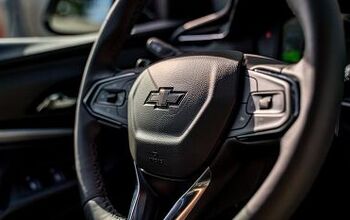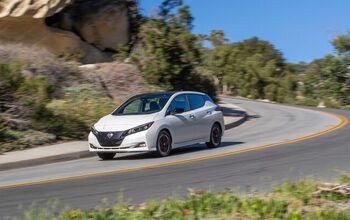Mercedes-Benz Spending $1 Billion to Build All-electric SUVs in, Where Else, Alabama
Mercedes-Benz is investing $1 billion into its Tuscaloosa, Alabama, assembly operations in order to facilitate the production of its first EQ-branded SUVs in 2020. The investment, timed to roughly coincide with the beginning of Mercedes-Benz ML production in Alabama, is expected to result in the hiring of another 600 employees.
In the near term, Mercedes-Benz has been open with its doubts regarding the profitability of pure electric vehicles. Evidently, the long-term view is different. And it probably doesn’t hurt to pour more money into a U.S. operations hub that accounts for nearly half the vehicles sold by the automaker in America.
Alabamians already build the GLE-Class (formerly the M-Class), GLS-Class (formerly the GL-Class), and the U.S.-market C-Class sedan for Mercedes-Benz. Those three vehicle lines — four if you count the separate GLE-Class Coupe — accounted for 49 percent of Mercedes-Benz USA car/SUV sales in 2017’s first eight months.
Who’d have thunk, 22 years ago when Mercedes-Benz announced Alabama would be home to the automaker’s first major non-German plant, that we would reach a point where Americans would be responsible for assembling most of the Mercedes-Benzes Americans buy?
Through the first eight months of 2017, Automotive News reports that Mercedes-Benz has built 53,024 copies of the C-Class (down 16 percent, year-over-year) but 147,068 SUVs, an 11-percent increase.
Alabama is also home to production of the four American Honda products, production of which is down slightly to 239,534 units year-to-date, AN says. Alabama also hosts production of the Hyundai Elantra, Sonata, and the Santa Fe Sport. Hyundai’s total Alabama production is down 6 percent, all on the account of the brand’s decreasingly popular sedans.
Back at Mercedes-Benz, the German automaker will spend some of this new $1 billion investment on the company’s fifth battery plant and an after-sales-oriented logistics hub. Mercedes-Benz was already reinvesting in its Alabama operations in order to update the body shop and assembly line for current production. Naturally, the package used to entice further Mercedes-Benz investment in Alabama will include statutory incentives, performance-based incentives, tax abatements, and tax credits, according to Alabama Commerce Secretary Greg Canfield.
Mercedes-Benz first unveiled the EQ idea with the Generation EQ Concept at 2016’s Paris auto show. The production version is expected to offer around 300 miles of all-electric range.
[Images: Daimler AG]
Timothy Cain is a contributing analyst at The Truth About Cars and Autofocus.ca and the founder and former editor of GoodCarBadCar.net. Follow on Twitter @timcaincars and Instagram.
More by Timothy Cain
Latest Car Reviews
Read moreLatest Product Reviews
Read moreRecent Comments
- Todd In Canada Mazda has a 3 year bumper to bumper & 5 year unlimited mileage drivetrain warranty. Mazdas are a DIY dream of high school auto mechanics 101 easy to work on reliable simplicity. IMO the Mazda is way better looking.
- Tane94 Blue Mini, love Minis because it's total custom ordering and the S has the BMW turbo engine.
- AZFelix What could possibly go wrong with putting your life in the robotic hands of precision crafted and expertly programmed machinery?
- Orange260z I'm facing the "tire aging out" issue as well - the Conti ECS on my 911 have 2017 date codes but have lots (likely >70%) tread remaining. The tires have spent quite little time in the sun, as the car has become a garage queen and has likely had ~10K kms put on in the last 5 years. I did notice that they were getting harder last year, as the car pushes more in corners and the back end breaks loose under heavy acceleration. I'll have to do a careful inspection for cracks when I get the car out for the summer in the coming weeks.
- VoGhost Interesting comments. Back in reality, AV is already here, and the experience to date has been that AV is far safer than most drivers. But I guess your "news" didn't tell you that, for some reason.



































Comments
Join the conversation
I like my steak medium rare. I like my coffee black with no sugar. And I like my German cars made in Germany, damn it!
As an Alabamian, there is an unspoken sense of pride that comes with with this, but after a few years it just faded into the background and became an entitlement. Because OF COURSE these cars are built here (and don't forget that Mercedes also exports a substantial minority of what they build here). These plants are mostly located in semi-rural areas outside of larger metro areas, so a lot of workers are predictably relatively uneducated, but very skilled (either in auto or in other trades, from machinists to poultry workers to textiles to cabinetry). The auto wages are a little better than other employers, but your average old-line union worker would balk at it...at least until they saw how much house you could buy in Tuscaloosa county with $200k. And $500/year in property taxes. It's all relative. The attitude here is sort of the opposite of what I saw from my Midwestern friends who cheered on the worst 80s/90s products from GM and Ford simply because they're "local" or "UAW made." I wonder how we'd feel if our state produced crap, as well. Are we fairweather fans or die-hards? Actually, I'm not super proud of the Santa Fe. Just saying.